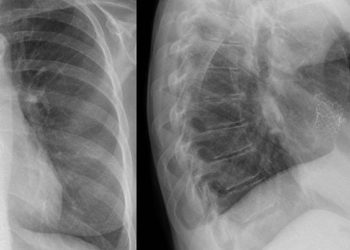2 Minute Medicine Rewind October 19, 2020
Vitamin D and the risk of dystocia: A case-control study
1. Compared to women who had spontaneous vaginal deliveries, women who underwent caesarian sections due to dystocia had decreased vitamin D level.
Evidence Rating Level: 3 (Average)
Dystocia, otherwise known as difficult or obstructed labor, is either directly or indirectly responsible for 30-60% of cesarean deliveries (C-sections). Vitamin D insufficiency during pregnancy is common and may be involved with labor contractions either through activating intracellular vitamin D receptors (VDR) in the myometrium and/or by affecting the availability of calcium for muscle contraction. This case-control study examined the associations of vitamin D levels in primiparous women in a Danish hospital who either gave birth by C-section following spontaneous onset of labour (cases, n=30) or by spontaneous vaginal delivery (controls, n=30). Women giving birth by C-section had lower levels of serum 25-hydroxyvitamin D versus controls (53.1 nmol/L vs. 69.9 nmol/L, p=0.02). There was no statistically significant difference between parathyroid hormone levels between cases and controls (2.25 pmol/L and 2.38 pmol/L, respectively). Additionally, though 78% of women were taking at least 10 µg (400 IU) vitamin D daily, 43% had a vitamin D sufficiency (25-hydroxyvitamin D <50 nmol/L). Of note, there were significant differences in background characteristics between cases and controls for maternal BMI at term (28.7 kg/m2 vs. 26.5 kg/m2, p<0.009), duration of gestation (40 weeks + 4 days vs. 40 weeks + 0 days, p=0.02), birth weight (3791 g vs. 3491 g, p=0.003) and use of epidural analgesia during labor (43.3% vs. 10%, p=0.004). Controlling for this last factor, however, showed no impact on the results. Ultimately, results of this study may bring attention to the role of vitamin D during childbirth and appropriate supplementation for pregnant mothers. Nonetheless, further studies should be done with a greater number of patients and across multiple study centres.
1. For patients undergoing surgical interventions for acute type A aortic dissections (AAAD), post-operative acute kidney injury was shown to increase patient mortality risk.
2. Risk factors associated with AKI occurrence included high BMI, chronic kidney disease, chronic liver disease, cardiopulmonary bypass duration, RBC transfusion, and hypoproteinemia.
3. Risk factors associated with in-hospital mortality for patients with AKI included AKI stage, lactic acidosis, CRRT, and deep hypothermic circulatory arrest.
Evidence Rating Level: 2 (Good)
Acute kidney injury (AKI) is a common complication after cardiac surgery. Particularly following surgical treatment for acute type A aortic dissections (AAAD), a life-threatening cardiac condition, AKIs occur at an incidence rate ranging from 20.2% to 66.7%. The variance in rate is partly due to the lack of a uniform definition of AKI. This study seeks to identify the incidence rate of AKI by the 2012 Kidney Disease Improving Global Outcomes Acute Injury (KDIGO) Work Group criteria, as well as to identify risk factors and in-hospital mortality for AKIs, after surgical interventions for AAAD. This retrospective cohort study included 335 patients with AAAD who underwent surgery while in hypothermic circulatory arrest at West China Hospital of Sichuan University. Of these patients, 71.944% experienced an AKI. By severity, 35.26% had AKI stage 1, 31.95% had AKI stage 2, and 32.78% had stage 3 AKI. After screening their medical records, risk factors found to be associated with AKI occurrence include body mass index (OR, 1.221), chronic kidney disease (OR, 12.352), chronic liver disease (OR, 2.207), cardiopulmonary bypass duration (OR, 1.008), red blood cell transfusion (OR, 1.186), and hypoproteinemia (OR, 5.091). In-hospital mortality for patients who experienced post-surgical AKIs was 21.16%. Risk factors associated for in-hospital mortality for patients who experienced AKI include AKI stage (OR, 3.322), deep hypothermic circulatory arrest (OR, 2.586), lactic acidosis (OR, 3.407) and continuous renal replacement therapy (OR, 3.156). Limitations to this study include that baseline serum creatinine may have only been taken post-AAAD in some patients which can affect the incidence of AKI. This study demonstrates that a significant portion of patients undergoing surgery for AAAD experience AKIs, which come with considerable mortality. It also provides insight into factors that may increase risk of AKI and its associated mortality. Further studies should seek factors which improve post-operative outcomes for AAAD patients by accounting for these AKI-associated risk factors, in a multicentre format.
1. Mothers with preterm deliveries have significantly different levels of metabolites among them compared to term mothers.
2. There are different levels of metabolites among mothers with spontaneous preterm deliveries and with medically-indicated spontaneous preterm deliveries with or without preeclampsia.
Evidence Rating Level: 2 (Good)
Mothers who have preterm deliveries (PTD) may experience an increased risk for cardiovascular disease up to three times of their baseline. Previous studies show that this increased risk may be due to metabolic disorders that occur during pregnancy, such as eclampsia, which accounts for 24-26% of the association, or postpartum, which accounts for 13-15% of the association. However, much of the increased risk still remains unaccounted for. Metabolomic profiling, in which a large number of circulating metabolites involved in various pathways are analyzed, has been successful in identifying early biomarkers for cardiovascular disease. Using this method of high-throughput assessment, this study analyzed 380 metabolites in 1330 women, collected up to 72 hours after giving birth, by either term delivery (n=980), medically indicated PTD (mPTD) with preeclampsia (n=79), mPTD without preeclampsia (n=52), and spontaneous PTD (SPTD, n=219). The study was performed using patients in the Boston Birth Cohort in a socially disadvantaged area with a predominantly minority population. Metabolomic profiles were most different between term controls and women having PTD with preeclampsia, in which they found a significant increase of 26 metabolites (diacylglycerols, triacylglycerols, phosphocholines and lysophosphocholines) and decrease in 11 metabolites in the latter (including nucleotides, steroids, and cholesteryl esters). Women having mPTD and preeclampsia had significantly more diacylglycerols and triacylglycerols in circulation, and fewer cholesteryl esters than women with mPTD only. mPTD only women only had significantly different phosphatidylethanolamines from at term women. Meanwhile, sPTD women also had a different metabolic profile than at-term mothers and those with mPTD with preeclampsia, though these groups did share similar metabolite changes when compared to at-term mothers. The different groups in this study showed differing levels of unique metabolites with some overlap, with some identified metabolites already known for being predictors of future cardiovascular disease. These findings will have to be replicated in other studies before identified metabolites can be used for follow-up longer-term studies to see if they are truly associated with increased risk of cardiovascular disease.
1. Higher amounts of weekly physical exercise were associated with better carotid-to-femoral pulse wave velocities but not with carotid distensibility, which are both markers of arterial stiffness.
2. Diabetic patients may benefit from a more profound correlation between physical exercise with carotid-to-femoral pulse wave velocity.
Evidence Rating Level: 2 (Good)
Arterial stiffness is a risk factor for cardiovascular disease, which can be altered by physical activity. This cross-sectional study (n= 1699) used data from the Maastricht Study to assess arterial stiffness by carotid-to-femoral pulse wave velocity (cfPWV) and carotid distensibility. Subjects were followed for a week and divided into inactive (75 min/week), insufficienctly active (75-150 min/week), regularly active (>150 min/week) and weekend warrior (>150 min/week but in ≤2 sessions) groups. Subjects were followed for 1 week to determine activity levels. Increasing amounts of physical activity per week were associated with lower cfPWV scores (lower arterial stiffness), with increasing activity correlating with better results between the exercise groups. This association showed as a more prominent trend in patients with diabetes mellitus type 2 . However, the other marker for arterial stiffness, carotid distensibility, was not associated with higher amounts of physical exercise and none of the exercise groups had a significantly different result compared to the inactive group (reference). Future studies should be done longitudinally to see bigger impacts of exercise on arterial stiffness. This study suggests that exercise, especially in diabetic patients, may beneficially improve arterial stiffness, a known cardiovascular disease risk factor.
1. Newborns exposed to methadone prenatally had worse neurobehavior scores than those who were not.
2. Infants belonging to one of four particular neurobehavioral profiles were associated with poorer cognitive and neuromotor outcomes at 24 months.
Evidence Rating Level: 2 (Good)
As the opioid crisis continues to take its toll in North America, many pregnant mothers are using opioid agonist therapy, such as methadone and buprenorphine, as safer, controlled prescription alternatives. Infants whose mothers used methadone treatment during pregnancy are known to exhibit differences in the Neonatal Intensive Care Unit Network Neurobehavioral Scale (NNNS). The long term effects on neurodevelopment of the infant is far more limited due to poorer quality or smaller studies. This study used data from the prospective, longitudinal Christchurch Methadone In Pregnancy (MIP) Study and had two aims. One was to compare neurobehaviors in infants exposed prenatally to methadone (n=86) to those who were not (n=103) and the other was to identify a specific neurobehavioral profile that was linked to worse neurodevelopmental outcomes at 2 years of age. Using NNNS summary scores, infants exposed to methadone prenatally had poorer attention, regulation, and quality of movement, increased excitability, arousability, expression of non-optimal reflexes, hypertonicity, and total signs of stress abstinence, including those of central nervous system, visual, genitourinary, and state. From this group of subjects, four unique neurobehavioral profiles were created. One profile, Profile 4, had poorer attention scores than most of the other profiles, required the most handling, had the lowest scores on self-regulation and the highest on arousal, excitability, hypertonicity, non-optimal and asymmetric reflexes, and exhibited the highest stress abstinence and poorest quality of movement. Infants of this profile had the poorest NSSS score and were more likely to be born to mothers on welfare with more pregnancies and terminations, to be male, to be born preterm and smaller at birth, to spend more than 2 weeks in a special care baby unit and more than 2 weeks in hospital postnatally, and to be more likely to need pharmacological treatment for neonatal abstinence syndrome. Children of this profile had the worst clinical outcomes at 24 months assessed by BSD-II, MDI and PDI, scales of child cognitive and neuromotor function, respectively. This study confirmed the findings of previous studies that exposure to methadone prenatally can significantly affect neurobehaviors at birth compared to unexposed infants. Furthermore, infants belonging to the certain neurobehavior profile 4 (13% of infants) had the worst outcomes of all methadone-exposed individuals at 24 months. These findings can help identify infants who may be at increased risk of worse neurodevelopment compared to others exposed to methadone prenatally.
Image: PD
©2020 2 Minute Medicine, Inc. All rights reserved. No works may be reproduced without expressed written consent from 2 Minute Medicine, Inc. Inquire about licensing here. No article should be construed as medical advice and is not intended as such by the authors or by 2 Minute Medicine, Inc.







